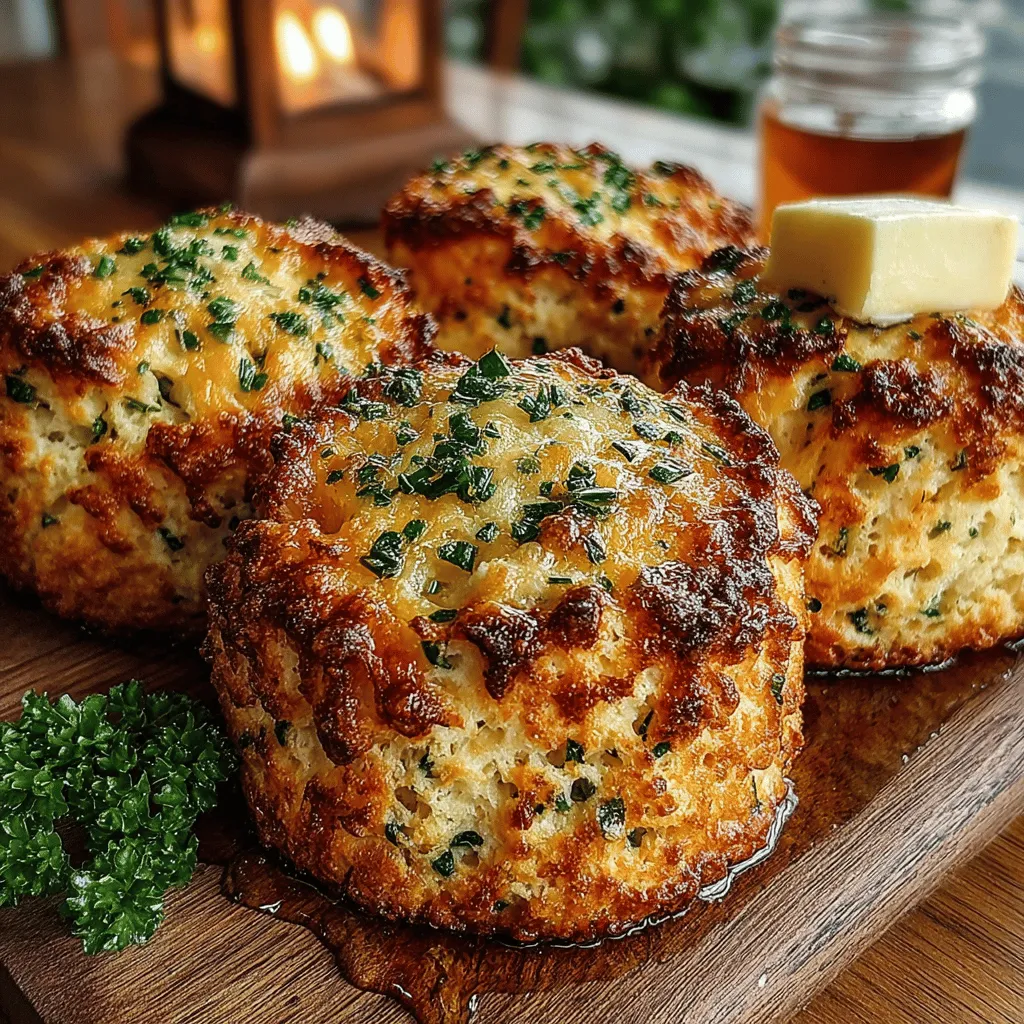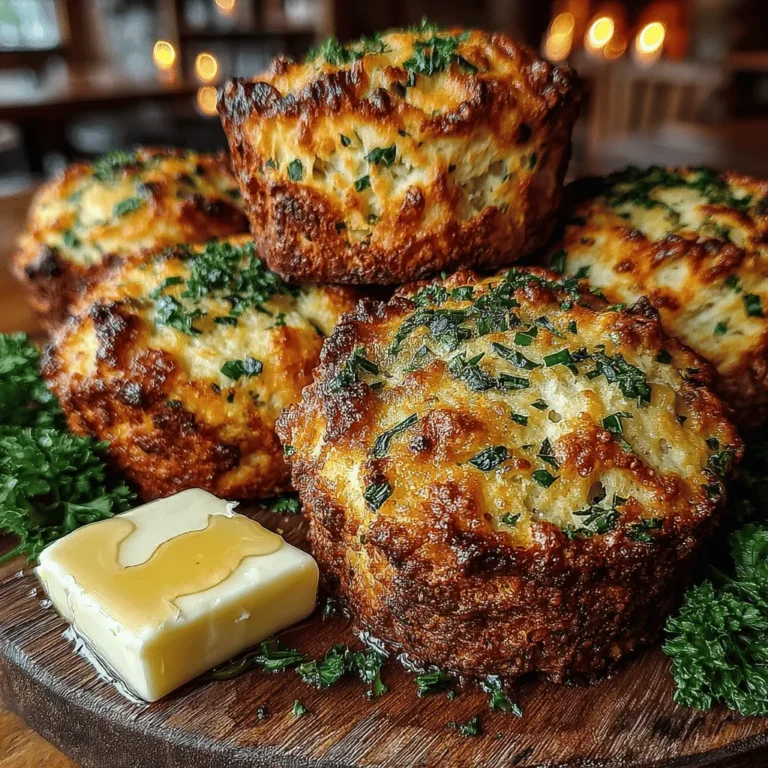Introduction
Savory biscuits are a cherished staple in many culinary traditions around the world, offering a delightful blend of flavor and texture that makes them a favorite among both home cooks and professional chefs. From the flaky, buttery biscuits served in Southern kitchens to the herb-infused varieties found in European cuisines, savory biscuits present a versatile option that can elevate any meal. One such recipe that stands out is the Savory Cheddar & Herb Biscuits, which combine the richness of sharp cheddar cheese with the fresh flavors of herbs, creating a delightful treat that is perfect for various occasions.
These Savory Cheddar & Herb Biscuits are not only a delicious addition to breakfast but also serve as an excellent snack or side dish, complementing soups, salads, and main courses alike. Their inviting aroma and golden-brown crust make them irresistible, while the soft and flaky interior promises a satisfying bite. In this article, we aim to provide you with a comprehensive guide to making these delectable biscuits, ensuring that you can enjoy them any time you like, whether it’s a cozy family breakfast or a festive gathering with friends.
Understanding the Ingredients
To achieve the perfect Savory Cheddar & Herb Biscuits, it is essential to understand the role of each ingredient in the recipe. This knowledge will not only enhance your baking skills but also allow you to make informed substitutions if needed.
All-Purpose Flour
All-purpose flour serves as the foundation of our biscuits, providing the necessary structure and texture. It contains a moderate level of protein, balancing the chewiness and tenderness that we desire in a biscuit. When mixed with the other ingredients, the flour forms gluten, which contributes to the overall texture of the finished product. For the best results, be sure to measure your flour accurately; too much can lead to dry biscuits, while too little can cause them to collapse.
Baking Powder
Baking powder is a crucial ingredient in biscuit-making, acting as a leavening agent that helps achieve a light and airy texture. When combined with moisture and heat, baking powder releases carbon dioxide, causing the dough to rise. It is vital to use fresh baking powder, as expired leavening agents can result in flat, dense biscuits. For our Savory Cheddar & Herb Biscuits, the right amount of baking powder is essential to ensure they rise beautifully in the oven.
Butter
Butter is the key to achieving the desired flaky texture in biscuits. When cold butter is cut into the flour, it creates small pockets of fat that, during baking, melt and steam, resulting in a light and flaky biscuit. It is important to use unsalted butter for this recipe to have better control over the saltiness. Additionally, keeping the butter cold until it is mixed with the dry ingredients is crucial; this helps to maintain the integrity of the fat, ensuring the biscuits remain tender rather than greasy.
Cheddar Cheese
The choice of cheese can significantly impact the flavor profile of your biscuits. For this recipe, sharp cheddar cheese is recommended for its bold and tangy flavor, which pairs beautifully with the herbs. Grating the cheese finely allows it to melt evenly throughout the dough, ensuring that every bite is rich and cheesy. For those who prefer a milder taste, medium or mild cheddar can be used, but keep in mind that it will alter the overall flavor of the biscuits.
Herbs
Fresh herbs play a vital role in enhancing the flavor of the Savory Cheddar & Herb Biscuits. In this recipe, we focus on chives and parsley, both of which add a burst of freshness. Chives offer a mild onion-like flavor, while parsley contributes a subtle earthiness. Using fresh herbs instead of dried ones is recommended, as they provide a vibrant flavor and aroma that elevates the biscuits to new heights. Feel free to experiment with other herbs such as thyme or rosemary, depending on your taste preferences.
Buttermilk
Buttermilk is an essential ingredient in this biscuit recipe, contributing moisture and a slight acidity that helps tenderize the dough. The acidity in buttermilk reacts with the baking powder, enhancing the leavening process and resulting in a lighter biscuit. If you don’t have buttermilk on hand, you can easily make a substitute by mixing regular milk with a teaspoon of vinegar or lemon juice and letting it sit for a few minutes. This will mimic the tangy flavor and acidity of buttermilk, ensuring your biscuits come out just as delicious.
Step-by-Step Instructions for Perfect Biscuits
Preheating the Oven
Before diving into the biscuit-making process, it is crucial to preheat your oven. Setting the right temperature is paramount for achieving evenly baked biscuits with a golden-brown crust. Preheating allows the oven to reach the desired temperature before you place the biscuits inside, ensuring that they begin to rise immediately. For Savory Cheddar & Herb Biscuits, aim for a temperature of 425°F (220°C).
To ensure an even bake, position your oven rack in the center of the oven. This allows for optimal air circulation, which is key to achieving that perfect rise and texture. If you have an oven thermometer, it can be helpful to check that your oven is accurately calibrated, as uneven temperatures can lead to inconsistent results.
By understanding the ingredients and following these initial steps, you will be well on your way to creating a batch of Savory Cheddar & Herb Biscuits that are sure to impress. In the next part of this article, we will delve deeper into the mixing and baking process, ensuring that your biscuits turn out perfectly every time. Stay tuned for more detailed instructions that will guide you through each step of this delicious recipe!

Combining Dry Ingredients
To create a well-balanced and flavorful biscuit, start by combining your dry ingredients. This step is crucial as it ensures even distribution of the leavening agents—baking powder and baking soda—as well as the spices.
1. Sifting: If your recipe calls for flour, it’s beneficial to sift it first. Sifting aerates the flour and eliminates clumps, resulting in a lighter biscuit texture. Use a fine-mesh sieve or a sifter, and sift the flour directly into a mixing bowl.
2. Adding Baking Powder and Salt: Next, add the appropriate amounts of baking powder and salt. It’s essential to mix these dry ingredients thoroughly. A whisk is an excellent tool for this task; it will help break up any clumps and ensure that the leavening agents are evenly distributed throughout the flour.
3. Incorporating Spices: If your recipe includes spices or herbs (like dried thyme or garlic powder), add them at this stage. Whisk these ingredients together until they are uniformly mixed into the flour, which will enhance the overall flavor of the biscuits.
Cutting in the Butter
The next step involves cutting in the butter, which is key to achieving the right crumb texture in your biscuits. Here’s how to do it effectively:
1. Butter Temperature: Ensure your butter is cold. Cold butter is essential for creating flaky layers in the biscuits. You can cut the butter into small cubes and place them in the freezer for about 15 minutes before starting this step.
2. Using a Pastry Cutter or Fork: Place the cold butter cubes into your dry ingredient mixture. Use a pastry cutter, fork, or your fingertips to cut the butter into the flour. The goal is to break the butter into small pieces, about the size of peas. Visual cues include a mixture that resembles coarse crumbs with some larger butter chunks remaining.
3. Avoid Overworking: Be careful not to overwork the dough during this process. Overworking can lead to tough biscuits. Stop when you can still see small bits of butter throughout the mixture; this will contribute to a flaky texture once baked.
Incorporating Cheese and Herbs
Adding the cheese and fresh herbs is an exciting part of the biscuit-making process. Here are tips to fold these ingredients without compromising the texture:
1. Choose Your Cheese: Use freshly grated sharp cheddar cheese for the best flavor. Grating cheese rather than cubing it allows for even melting and distribution throughout the biscuits.
2. Adding Herbs: Fresh herbs like chives, parsley, or rosemary should be finely chopped to ensure they blend seamlessly into the dough. Add the cheese and herbs to the butter-flour mixture and gently fold them in using a spatula.
3. Folding Technique: Use a gentle folding motion to combine the ingredients. This technique helps maintain the integrity of the dough without developing too much gluten, which can lead to a dense biscuit.
Mixing in Buttermilk
The next step is to add buttermilk, which helps bind the ingredients while contributing to the biscuit’s moistness and tangy flavor.
1. Gradual Addition: Pour the buttermilk into the dry mixture gradually. Start with about half and mix gently with a spatula or wooden spoon. Once incorporated, add the rest of the buttermilk.
2. Consistent Dough: Mix until just combined. The dough should be soft and slightly sticky but not overly wet. If it feels too dry, add a splash more buttermilk. Remember, overmixing at this stage can lead to tough biscuits, so be gentle!
Shaping the Biscuits
Once your biscuit dough is ready, it’s time to shape it for baking.
1. Flouring Your Surface: Lightly flour a clean work surface. Turn out the dough onto the floured surface and pat it into a rectangle or disc about 1 inch thick.
2. Cutting Biscuits: Use a sharp biscuit cutter or a glass to cut out individual biscuits. Press straight down without twisting to ensure they rise properly. Gather any scraps, gently knead them together, and cut out more biscuits.
3. Spacing: Place the biscuits on a baking sheet lined with parchment paper. Leave some space between each biscuit to allow for expansion during baking.
Baking Process
Baking is where your biscuits transform into delicious golden treats.
1. Preheating: Preheat your oven to 425°F (220°C). A hot oven is vital for achieving that perfect rise.
2. Baking Time: Bake the biscuits for 12 to 15 minutes, or until they are golden brown on top. Keep an eye on them, as baking times can vary based on your oven.
3. Checking for Doneness: To check if your biscuits are done, look for a golden-brown color. You can also gently tap the top; if it sounds hollow, they are ready.
Serving Suggestions
Savory Cheddar & Herb Biscuits are versatile and can be enjoyed in various ways:
1. Pairing with Soups: These biscuits pair wonderfully with creamy soups like tomato basil or potato leek. Their cheesy, herbaceous flavor adds a delightful contrast to the rich soup.
2. Accompaniment to Salads: Serve them alongside a fresh salad for lunch or dinner. The biscuits can complement a variety of dressings and ingredients, enhancing your meal.
3. Spread Options: Try serving the biscuits warm with butter, honey, or a savory spread like herb-infused cream cheese. The combination of flavors will elevate your dining experience.
Storage and Reheating Tips
To keep your biscuits fresh after baking, follow these storage tips:
1. Storing Leftovers: Allow the biscuits to cool completely before storing them in an airtight container at room temperature. They can stay fresh for up to three days.
2. Freezing: For longer storage, freeze the unbaked biscuit dough. Place cut biscuits on a baking sheet, freeze until solid, then transfer them to a freezer-safe bag. They can be baked directly from the freezer; just add a couple of extra minutes to the baking time.
3. Reheating: If you have leftover biscuits, you can reheat them in a preheated oven at 350°F (175°C) for about 5-10 minutes until warmed through. This will help restore their flaky texture.
Health Benefits of Ingredients
These biscuits, while indulgent, also offer nutritional benefits:
1. Calcium from Cheese: The sharp cheddar cheese in this recipe provides a good source of calcium, which is essential for bone health.
2. Vitamins from Herbs: Fresh herbs not only add flavor but also come packed with vitamins and antioxidants. Herbs like parsley and chives are particularly high in vitamins A, C, and K.
3. Balanced Indulgence: While Savory Cheddar & Herb Biscuits are a treat, they can fit into a balanced diet. Enjoy them in moderation as part of a meal that includes a variety of food groups.
Conclusion
Savory Cheddar & Herb Biscuits are a delightful addition to any meal, bringing warmth and comfort to your table. Whether you serve them with a hearty soup, a fresh salad, or simply enjoy them on their own, these biscuits are sure to impress. Their rich flavors and flaky texture make them a versatile choice for breakfast, lunch, or dinner.
Encourage creativity in the kitchen by trying different cheeses or herbs in your biscuits. Each variation can lead to a unique twist on this classic recipe. We invite you to try making these biscuits and explore your own flavor combinations. Happy baking!


